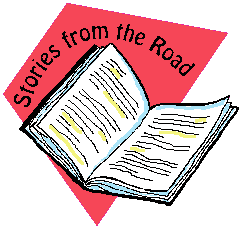|
Sister Act(Filed from Grand Canyon National Park, Arizona at 1:50 a.m. on July 20, 1999) Note: Names have been changed to protect the innocent. Temple Square, ground zero for members of the Mormon Church, is smack in the middle of Salt Lake City. The Square takes up an entire city block and in Salt Lake, blocks are big. Among the buildings in Temple Square are the Temple (bigger), the Tabernacle (round) and the North and South Visitors Centers. Fen and I decide to check the Square out, in part because we have two burning questions: where the term "Mormon" comes from, and why the Mormon Church uses the word "Zion" on most everything in town. We begin our quest for answers at the South Visitors Center. Upon entering, we are greeted by a young woman behind the information desk with a badge that says "Sister Anderson." Fen asks a question first. "Um, could you tell me where the term Mormon comes from?" "Good question," Sister Anderson says. "It comes from the Book of Mormon." She holds up the bible-sized book so that we can see it. "It's the name of a man who abridged the many books of the prophets." I get it: Mormon was the editor. "So was Mormon his first name or his last name?" I ask. "Well," she says, "I'm not really sure. It's just his name. See, there were lots of prophets." Sister Anderson opens up the Book to what looks like the table of contents. A listing on the page reads "Book of Mormon," "Book of Moroni" and so on. I accept that Mormon and Moroni might have gone by one name (a la Madonna) and leave it at that. "One more thing," I continue. "Why do all the buildings in town say Zion on them? Where does that come from?" "Yes, that's a good question," Sister Anderson says, and I start to wonder if I'm the only person who's ever asked these questions. "Well, let's see," the Sister continues, "Zion is a place where you can practice your faith freely." "Hmm, I thought it was a place in Israel," I say, although I'm not really sure. "Well, sorta," Sister says. "It's a place to practice. A place where the gathering will be for the children of Israel." "So are the Mormons and the Jews connected somehow?" I ask. "Well, umm...it's like a place of dwelling or a Zion community. It's a wonderful place, a heavenly place..." Sister Anderson gets a dreamy look on her face as she is speaking. I think I'm losing her, so I stop asking questions and get directions to the Temple Square tour. Turns out it leaves from the Flagpole every ten minutes so Fen and I make our way there. We find two more Sisters at the flagpole, Sister Butterfield and Sister Langton. They are both young, maybe twenty, and extremely fresh-faced. Sister Butterfield's hair is in a neat braid and her floral dress stretches below the knee and is perfectly pressed. Her brown shoes are lace-ups with a modest heel. Sister Langton is also conservatively dressed and wears sturdy black shoes with a rubber sole. I think I've seen them at Nordstrom. For some reason, I decide to ask my Zion question again, this time of Sister Butterfield. "Well," she says in a measured yet pleasant tone, "Zion is a place where we can practice our faith. It is a special place." A small group starts to form and in a few minutes our tour begins. One older couple is visiting from Minneapolis and another twosome is from Maryland. A middle-aged man and his two teenage kids are here from Scotland. The Sisters will be leading our tour jointly and they start off by asking everyone their name. They shake each person's hand in a forthright manner, looking straight into their eyes. They smile prettily, and politely. Soon we're all shaking hands. We walk around to the side of the Temple first and Sister Butterfield offers a brief introduction. It's her last comment which catches my attention. "At the end of the tour we'll be giving you a guest card so that you can request more information. A representative will then come to your home to visit." For some reason, I was expecting an architectural tour. We learn from Sister Butterfield that the Mormons came to this valley in July of 1847. Brigham Young was the leader of the pack, and when he saw the Temple site he allegedly proclaimed "this is the place." And his minions started to build the Temple, block by granite block. The Sister proceeds to tell us that each block used to build the Temple weighed 5,600 pounds and that it took a team of oxen (presumably with driver) four days to haul each and every block from a nearby quarry. That may be why it took forty years to build the church. It was obviously worth it, though, since the Temple is a beauty, an imposing building with spires reaching to the sky. Atop the building stands a golden figure. I have to ask. "It's the Angel Moroni," Sister Butterfield tells me, and I remember hearing his name earlier at the Visitors Center. "Angel Moroni was an ancient American prophet." I didn't know there were any American prophets but I'm no expert so I don't disagree. At this point, Sister Butterfield passes the baton, so to speak, to Sister Langton. "The Temple is the house of the Lord," she says. "It's a very sacred place. As members of the Mormon faith, we take four vows: charity, chastity, integrity and sacrifice. We also learn about Jesus Christ our savior. Within the Temple we can take the sacred covenants, like marriage. This strengthens the family relationship and the hope of having an eternal family beyond." Sister Langton is almost teary-eyed as she's saying this. "Family is so special to me," she continues. "The heavenly father, he wants us to stay together." This last snippet resonates with me since I remember reading that a central tenet to the Mormon faith is the prospect of bringing both current and past family members into the Kingdom of Heaven. This is one of the reasons why genealogy is so important to Mormons: if you can track down past relatives you can baptize them posthumously and thereby guarantee their entrance through the pearly gates. It's an interesting concept. Sister Butterfield jumps in again. "The Book of Mormon is a record of God's dealings with the people of ancient America." I didn't know that God had come to America -- I thought he had hung around Galilee. Again I keep my mouth shut as I'm uncertain of the facts. Sister Butterfield continues to smile prettily and finally has a question of her own. "Do you have a religious background?" she asks the older couple behind me. "We're Catholic," the wife replies. "Oh, yes," the Sister says. "That's a beautiful religion. And you?" she asks the couple from Maryland. "Episcopalian," the wife replies. More positive feedback. When she gets to the Scotsman, he demurs. "I'd rather keep it to myself," he says, shifting from one leg to the other. Sensing a bit of tension, Sister Butterfield directs us all toward the Tabernacle. Along the way, I take Sister Butterfield aside and ask her to tell me about God's visit to America. She seems delighted that I've asked this question and proceeds to tell me that God did in fact pay a visit to America, sometime between 600 B.C. and 400 A.D. Once inside the Tabernacle, it's Sister Butterfield's turn again. We learn that the building has great acoustics and was built as a place for Brigham Young to address his flock. The wooden benches are the original ones, made of pine which is over a hundred years old. The pine has been painted to look like oak. The stately columns all around are also made of pine, although in this case they've been painted to look like marble. "This is an inspired building!" Sister Langton chimes in. "It was inspired by the prophet of God!" The Scotsman asks about the present-day prophet and we get a breakdown of church hierarchy. One prophet leads the church and he is assisted by twelve apostles. I'm surprised that he's referred to as "the prophet" since it seems a bit monopolistic. Arabs have Allah and Catholics have the Pope, at least on Earth. Back outside, I take Sister Butterfield aside once again. "I'm confused," I tell her. "If your man is the prophet, what about the prophets of all the other religions? I mean, the Catholics have their man and the Arabs and the Jews...how do you know that your man is THE man?" Sister Butterfield smiles at me sweetly and looks me straight in the eye. "Well," she begins, "you have to pray. You study the words of our prophet and then you decide." Our prophet? What about my prophet? Doesn't he rate? I start to think that Mormons are real homers, perhaps a bit too much for my taste. "Pretty hard sell here," Fen says. At this point I catch the Scotsman and his kids slinking away out of the corner of my eye. The last stop on our tour is the North Visitors Center, where we're treated to a one-minute recording by someone who's doing a voice-over of Jesus Christ. "I hope this is really only a minute long," Fen says, as he starts to fidget and look perplexed. The recording is indeed brief but it's not over yet. Near the exit we get the sales pitch once again. "If you'd like this book," Sister Butterfield says, holding up the Book of Mormon, "we'll send a representative with it to your home." The couple from Maryland is now fidgeting. Everyone politely declines to fill out the card. We all say our goodbyes and Fen and I head back out to Temple Square. "There's something interesting going on here," I say. "There are only Sisters in Temple Square. Where are the Brothers?" "Probably at home drinking beer," Fen says. "Anyway, I'm sure the Sisters are much cuter."
© 1999 Elaine Sosa San Francisco, California
back to stories index roadsage home
|







